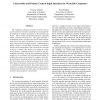Free Online Productivity Tools
i2Speak
i2Symbol
i2OCR
iTex2Img
iWeb2Print
iWeb2Shot
i2Type
iPdf2Split
iPdf2Merge
i2Bopomofo
i2Arabic
i2Style
i2Image
i2PDF
iLatex2Rtf
Sci2ools
PERCOM
2006
ACM
2006
ACM
A Keystroke and Pointer Control Input Interface for Wearable Computers
The widespread adoption of mobile electronic devices and the advent of wearable computing has encouraged the development of compact alternatives to the keyboard and mouse. These include one-handed keyboards, digitizing tablets, and glove-based devices. This paper describes a combination pointer position and non-chorded keystroke input device that relies on miniature wrist-worn wireless video cameras that track finger position. A Hidden Markov Model is used to correlate finger movements to keystrokes during a brief training phase, after which the user can type in the air or above a flat surface as if typing on a standard keyboard. Language statistics are used to help disambiguate keystrokes, allowing the assignment of multiple unique keys to each finger and obviating chorded input. In addition, the system can be trained to recognize certain finger positions for switching between input modes; for example, from typing mode to pointer movement mode. In the latter mode of operation, the po...
Combination Pointer Position | PERCOM 2006 | Pointer Control Mode | Pointer Movement Mode | Wireless Networks |
| Added | 24 Dec 2009 |
| Updated | 24 Dec 2009 |
| Type | Conference |
| Year | 2006 |
| Where | PERCOM |
| Authors | Farooq Ahmad, Petr Musílek |
Comments (0)

